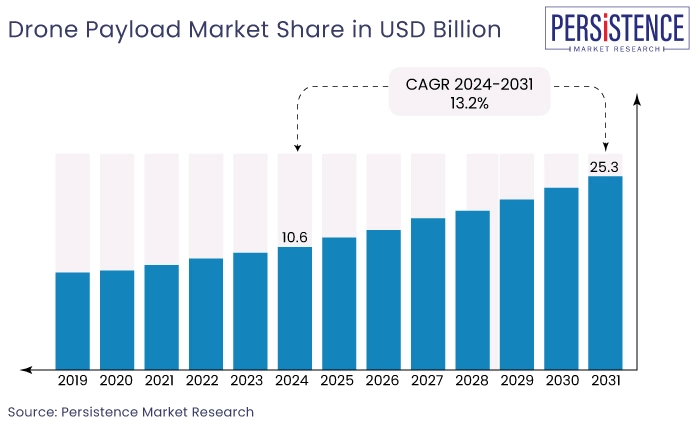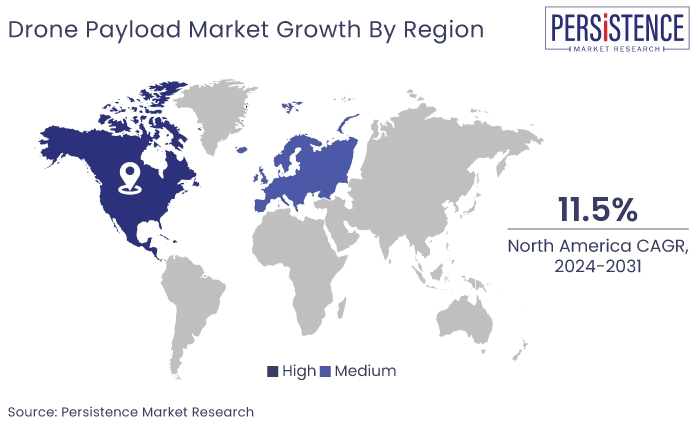ID: PMRREP34627| Upcoming | Format: PDF, Excel, PPT* | IT and Telecommunication

The global drone payload market is estimated to value at US$25.3 Bn by the end of 2031 from US$10.6 Bn recorded in 2024. The market is expected to secure a CAGR of 13.2% in the forthcoming years from 2024 to 2031.
Key Highlights of the Market
|
Market Attributes |
Key Insights |
|
Drone Payload Market Size (2024E) |
US$10.6 Bn |
|
Projected Market Value (2031F) |
US$25.3 Bn |
|
Global Market Growth Rate (CAGR 2024 to 2031) |
13.2% |
|
Historical Market Growth Rate (CAGR 2019 to 2024) |
11.6% |
The materials or instruments that drones utilize to do certain tasks are known as payloads; these can include sensors, cameras, medical supplies, and delivery goods.
After being dominated by military and defense applications for a while, the industry has significantly grown to cover consumer, commercial, and industrial uses.
Drones with high-resolution cameras and sensors are transforming fields like mining, construction, agriculture, and environmental monitoring by facilitating accurate data collection and processing.
Drones with advanced communication and navigation systems are in higher demand because they allow for more accurate and dependable remote operations—even in difficult circumstances.
Innovations in the reduction of weight and size of payload components are also essential since they enable drones to carry more loads without sacrificing flying performance. This includes the creation of batteries that are lighter and more effective, extending flight durations and operational ranges.

The quick advancement of drone technology, which has greatly improved payload capacities, durability, and precision, is one of the main contributing causes.
Advancements in sensor technology, component miniaturization, and incorporation of cutting-edge materials have made it possible for drones to transport increasingly complex payloads, including communication devices, LiDAR, thermal imaging sensors, and high-resolution cameras.
A major factor in enabling the use of drones for commercial purposes has been the steady easing of airspace limitations and regulatory backing.
Payload capacity are increasing as drone capabilities develop, making it possible to carry more advanced and varied technology. This covers communication devices, delivery packages, LiDAR systems, sophisticated sensors, and high-resolution cameras.
In addition, companies are concentrating on reducing the size of payload elements while maintaining functioning, which will increase drones' operational range and battery life.
Further expansion of the market is anticipated due to the acceleration of cooperation between developers of payload technology and drone manufacturers, which will drive the incorporation of cutting-edge technologies.
Increasing Adoption of Drones for Aerial Surveillance and Monitoring
Drones with specialized payloads, like thermal imaging sensors, multispectral sensors, LiDAR systems, and high-resolution cameras, allow for economical and effective aerial surveillance in a variety of industries.
Drones provide real-time data on crop health, moisture levels, and soil conditions in industries like agriculture, enabling precision farming techniques that improve yields and optimize crop management strategies.
Drones are used in the infrastructure and construction industries to monitor project progress, investigate hazardous or inaccessible places, and make sure safety regulations are being followed.
Drones are also essential for environmental monitoring, wildlife population monitoring, search and rescue operations in distant or disaster-affected areas, and environmental assessment and management.
Rising Investments in Defense and Security Applications
To improve military operations, border surveillance, and national security measures, governments and defense organizations over the world are progressively using unmanned aircraft systems (UAS) outfitted with sophisticated payloads.
Target acquisition, reconnaissance, and intelligence gathering in real-time are made possible by these drones' high-resolution cameras, infrared sensors, radar systems, and even weapons payloads. These capabilities can be applied to both conventional and asymmetric warfare scenarios.
Defense forces' situational awareness and operational efficacy are improved by drones' ability to function in a variety of situations, such as inclement weather and isolated locations.
In addition to conventional manned aircraft and ground-based surveillance techniques, drones offer vital surveillance capabilities that complement these approaches and minimize hazards to people while also being more affordable.
Safety Concerns Related to Autonomous Flight Operations
Autonomous drones, furnished with sophisticated sensors and navigation systems, provide capacities for unmanned missions across multiple domains, such as emergency response, infrastructure inspection, and agricultural.
Concerns about the dependability and security of autonomous operations, particularly in crowded airspace and urban settings, still exist, nonetheless.
Continuous technological developments in drones, such as better communication systems, fail-safe mechanisms that are dependable in emergency scenarios, and sensors that are better equipped to identify obstacles, are necessary to address safety concerns associated with autonomous flying operations.
Standardized safety procedures and public confidence in autonomous drone operations are the results of industry players, regulatory agencies, and academic institutions working together.
Lack of Skilled Personnel for Drone Operation and Maintenance
Drone use is spreading in several industries, including public safety, construction, agricultural, and infrastructure inspection. As a result, there is an increasing need for qualified individuals who can operate and maintain these advanced unmanned aerial systems (UAS).
Operators need to be skilled in flight planning, navigating through various situations with drones, and deciphering data from sophisticated sensors like LiDAR, thermal imaging, and multispectral cameras.
To ensure safe operations, maintenance staff also need to be proficient in conducting regular inspections, diagnosing technological problems, and guaranteeing regulatory compliance.
Development of Lightweight and Compact Payload Solutions for Enhanced Flight Endurance
Longer flight periods and increased operational efficiency are in high demand as drones become more and more integrated into numerous businesses.
Drone flight endurance can be greatly increased by using lightweight payloads, such as sophisticated miniaturized sensors, cameras, and communication systems, which lower total weight and power consumption. This is especially important for applications in fields where drones frequently need to cover large regions or stay in the air for extended periods of time, such as agricultural, environmental monitoring, and infrastructure inspection.
For example, developments in the field of micro-electromechanical systems (MEMS) are making it possible to create more compact and effective sensors that can carry out intricate operations like thermal mapping, LiDAR scanning, and high-resolution imaging.
These lightweight payloads increase the drone's safety and maneuverability while also extending its flight time, enabling more accurate and consistent data collecting.
Collaboration with Defense and Security Sectors for Advanced Surveillance and Reconnaissance
Due to the growing requirement for improved situational awareness, real-time intelligence, and efficient threat detection, military and security organizations are placing an increasing amount of emphasis on sophisticated, dependable, and adaptable drone systems.
Companies that want to meet the strict criteria of military and security operations can create and implement specific payloads including high-resolution cameras, thermal imaging sensors, radar systems, and electronic warfare tools by collaborating with defense and security organizations.
|
Category |
Projected CAGR through 2031 |
|
Type – EO/IR |
14.2% |
|
End User – Defence |
13.1% |
EO/IR Segment to Account for a Significant Share
With the combination of electro-optical and infrared imaging capabilities, EO/IR cameras offer complete daytime and nighttime surveillance and reconnaissance systems. They are essential for military and defense operations because accurate target acquisition and real-time situational awareness are critical due to their dual purpose.
To efficiently monitor and respond to possible threats, EO/IR payloads are also widely utilized in border security, law enforcement, and public safety.
The performance and integration of EO/IR systems have been further improved by technological developments in sensor downsizing, image processing, and data analytics, making them more useful and accessible for a wider range of applications.
The need for unmanned aerial vehicles (UAVs) with sophisticated imaging systems is increasing, and this is prompting large investments in the creation of next-generation EO/IR payloads.
Defence Segment to Grow Notably in Drone Payload
The evolving character of warfare and growing worries about global security have prompted defense organizations to give modern technologies like unmanned aerial systems (UAS) top priority when integrating them into their operations.
Drones with specialized payloads—like thermal imaging sensors, electronic intelligence systems, signal intelligence, and infrared (EO/IR) cameras—offer unmatched capabilities for target acquisition, surveillance, reconnaissance, and situational awareness.
Real-time data collection and analysis is made possible by these payloads, which is essential for mission and operating decision-making.
The increasing need for these advanced systems is driven by the continued improvements in drone technology and payload efficiency, as well as the growing global defense budget investments.
Furthermore, the growing focus on upgrading military forces' operating capabilities and modernizing them promotes the use of drones carrying sophisticated payloads.
|
Region |
CAGR through 2031 |
|
North America |
11.5% |
|
Europe |
9.9% |
North America Remains the Global Leader
North America is the most significant shareholder in the global market and is expected to grow at a CAGR of 11.5 % during the forecast period.
Unmanned aerial systems (UAS) get significant funding from the US military and government for defense and security purposes, which drives up demand for sophisticated payloads.
Furthermore, drone operations are becoming more and more supported by North American regulations. To enable commercial and civilian drone usage while maintaining safety, the Federal Aviation Administration (FAA) in the US has been actively working to integrate drones into the national airspace.
The acceleration of market growth is facilitated by regulatory assistance, which encourages wider implementation in several industries such as emergency response, infrastructure inspection, and agricultural.
Europe to Exhibit a Notable CAGR in the Drone Payload Market
The European market is projected to secure a CAGR of 9.9% in the forecast period from 2024 to 2031. High-resolution cameras, infrared imaging systems, and LiDAR sensors are just a few of the cutting-edge payload solutions being developed by tech companies and drone manufacturers in Europe.
Furthermore, due to the region's emphasis on sustainable development, effective resource management, and precision farming, there is a particularly high demand for drones in the agricultural, environmental monitoring, and infrastructure inspection sectors in Europe.
European nations are also making significant investments in smart city projects, where drones are essential for public safety, traffic control, and urban planning.
The need for advanced payloads in the defense industry is being further driven by the increasing integration of drones by European governments for border control, surveillance, and reconnaissance in military and security activities.
Furthermore, the existence of strategic partnerships between European academic institutions and drone technology businesses encourages ongoing innovation and the advancement of state-of-the-art drone payload technologies.

Global companies are making significant R&D investments to create payloads that are lighter, more capable, and more efficient. To stay competitive, innovations like AI integration, longer-lasting batteries, and more accurate sensors are essential. They are also working on growing their footprints in important areas including Asia Pacific, Europe, and North America.
By Type
By End User
By Region
Drone payloads are in demand because to their critical role in improving aerial capabilities in various industries, including public safety, infrastructure inspection, and agricultural.
The defence segment recorded the significant market share.
The market's potential can be expanded across multiple industries by utilizing AI-powered payloads, which can improve autonomous capabilities, unlock new functionalities.
North America to account for the significant share in the market.
Some of the leading companies include Elbit Systems Ltd., IMSAR LLC, BAE Systems PLC, and Parrot SA.
|
Attributes |
Details |
|
Forecast Period |
2024 to 2031 |
|
Historical Data Available for |
2018 to 2023 |
|
Market Analysis |
US$ Billion for Value |
|
Key Regions Covered |
|
|
Key Market Segments Covered |
|
|
Key Companies Profiled in the Report |
|
|
Report Coverage |
|
|
Customization & Pricing |
Available upon request |
Delivery Timelines
For more information on this report and its delivery timelines please get in touch with our sales team.
About Author